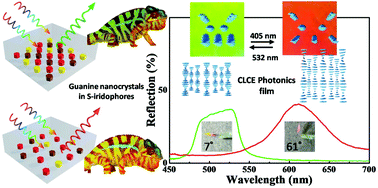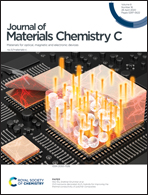Bio-inspired design of active photo-mechano-chemically dual-responsive photonic film based on cholesteric liquid crystal elastomers†
Abstract
Chameleons, which are among the poikilotherms, can rapidly change color for camouflage, communication and thermoregulation. These cold-blooded animals physiologically shift color through the active tuning of lattices of guanine nanocrystals within a superficial thick layer of dermal iridophores. This active tuning can be described as alternating different refractive indices of nano-reflectors, thereby generating interference of light waves. The self-regulation of the skin behind its dynamic color changing ability makes it the ultimate “biomimetic surface” and a continued source of inspiration. We presented a deformation-color multi-responsive actuator whose response is controlled by delicate light to mimic these adaptive functions. This soft smart material is developed by well-aligned cholesteric liquid crystal elastomers (CLCE). It performs a 185 nm wavelength shift of selective reflection and is switched by reacting to exposure time. Effective optical management is critical for the operation of many modern technologies. These results demonstrate distinctive potential opportunities for LC elastomers to control light, thereby enabling new applications of modern technologies to textiles, optics, and architecture.



 Please wait while we load your content...
Please wait while we load your content...